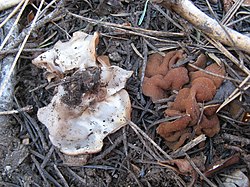Top Qs
Timeline
Chat
Perspective
Discina ancilis
Species of fungus From Wikipedia, the free encyclopedia
Remove ads
Discina ancilis, commonly known as pig's ears[1][2][3] is a brown to tannish, wrinkled, cup- or ear-shaped fungus, sometimes with short, stout stalk.
This article needs additional citations for verification. (October 2014) |
Remove ads
Taxonomy
The spores of D. ancilis are quite similar to those of mushrooms in the genus Gyromitra, so some mycologists classify it there.[citation needed]
Description
The cup measures 2–10 centimetres (3⁄4–4 inches) wide,[4] with a disc-like, whitish exterior, and a dark brown to tan interior. The cup is often wrinkled to convoluted, with the edges turned downward. The flesh is brittle.[5] The stipe (when present) is up to 1 cm (3⁄8 in) long and 3 cm thick; it is whitish to brownish in color.[5]
Microscopic characteristics
The spores are 25–35 x 11–16 μm, spindle shaped, minutely roughened, with a large central oil drop and two smaller ones at each end.[5]
Similar species
Disciotis venosa is more deeply veined, and has smooth spores; it is typically found in deciduous woods. Other similar species of Discina must be differentiated microscopically. Peziza repanda is also similar.[4] In the Pacific Northwest, D. leucoxantha and D. olympiana are similar.[6] It also resembles Gyromitra melaleucoides.[5]
Remove ads
Distribution and habitat
It is found singularly or in groups, on humus or rotten wood in coniferous areas; near melting snowbanks in western mountains. It is found in temperate areas of North America.[6] It comes into fruiting from May–July.
Edibility
It is considered edible by some authors,[7] but not others;[8] it can be confused with other potentially toxic species.[7] It should be cooked before consumption.[4]
References
Wikiwand - on
Seamless Wikipedia browsing. On steroids.
Remove ads

